A fantastic four day passage from Bonaire to the San Blas archipelago east of Panama had us making landfall in the Hollandes Cay or the island of Banedup on Lisa's birthday. The corridor past Cartegena, Columbia is known for nasty weather. We were lucky to strike it at just the right time and with high but consistent winds had a swift and comfy ride.
|
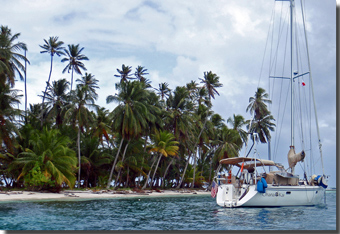
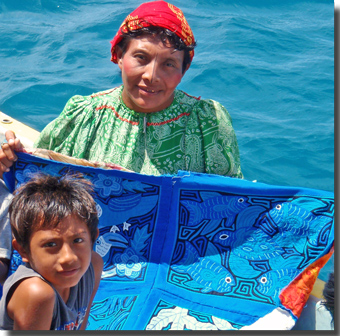
|
Kuna Indians
As one of the largest remaining indigenous Native South American Indians tribes, they now number about 55,000. They were originally driven from the Panama mainland by the Spanish Invasion and settled in the some 350 islands of the San Blas archipelago. They have continue to maintain their primitive traditions and cultural lifestyle over all these years.
We arrived at sunrise to find refuge in the protected anchorage of Banedup island or the Hollandes Cay. AKA the "swimming pool" . Shallow, warm and crystal clear waters surrounding the low lying palm covered islands were very inviting. We had no sooner dropped the anchor then we were visited by locals rowing out in their canoe or ulu to sell us their beautiful molas, fresh fish, coconuts and gather $5 for our stay.
Those who have made more money may now have outboard engines on their dug outs and travel as much as 3 hours just to sell their goods.
By evening, we were well acquainted with our new neighbors and enjoying a pot luck dinner upon shore. We spent a week here, and a few days in Coco Banderas. Bruce kitesurfing each day, Lisa snorkeling to discover a new finds of spotted eagle rays and the boys endless days of play with the friends from s/v Imagine and s/v Vagabond Heart. Lord of the Flies lives on. |
|
The land is not divided into parcels or fenced off, they believe that it belongs to all of their tribe as a whole. This goes as well for every coconut that grows there. As a person traveling though, you are not allowed to take that which does not belong to you. Their primary export is coconuts and families take turns in 3 month intervals living on the outlying islands to tend this crop.
|
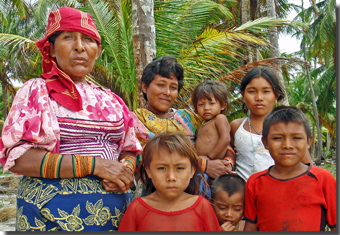
|
We met the families living on many of these islands. One family member usually spoke at least a few words of english and we speaking survival spanish and masters of charades got along well. They were happy to give us the 5 minute tour of their island, treat us to new foods, and practice their language skills. The kids love to get their photos taken but getting them to smile is a difficult task.
One family lives at each end and one in the middle. Though they live by simple standard, they take great pride at the care and upkeep of their land and coconut groves. Victor, nearly blind, once worked on the panama canal now does an amazing job on his own lands.
|
They live in simple huts made entirely out of quick growing palm fronds and tree trunks. Intricately laced roofs tied together with only jungle creeping vines. Their furniture consists mostly of hammocks as the low lying islands usually have damp grounds. The kitchen is an open firepit with a few pots and pans that are now brought back from occasional trips to Colon or Panama City.
A diet primarily of fruit and fish: bananas, coconut, cassava, shell fish as you can see the pile of immature conch shells beneath the woman's feet to the right. They did introduce us to a new food they called "fruta de mame" I am spelling it phonetically as we had never seen something like it before and are still not sure what it is. The pit inside was a large as a grapefruit, the skin very thin and course. The half inch of fruit that you recover from inside was grainy and colored like a mango, with out any real distinct taste.
|
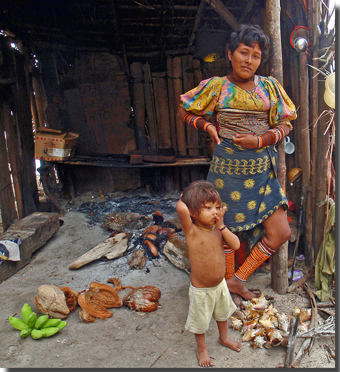
|
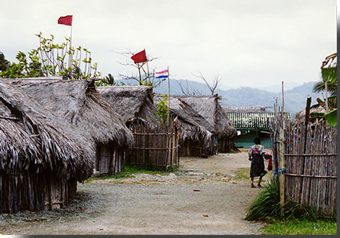
The local peoples day starts early before sunrise often to tend their crops or fishing but by 1pm everyone meets here, every day for a town meeting to discuss any thing and every thing. They retire early to their own huts and their hammock. The second hut chicha, is also the name for the intoxicating drink and a similarly named ceremony that takes place twice a year.
Some islands have water catchment systems, some closer to shore actually have one spicket plumbed in, but most have a well. It is common as well to find a long drop toilet set out over the water where there is greater tidal exchange. Surprisingly enough, you are also likely to find a basketball court there.
|
Each of the larger islands can house up to 20+ families and will also have two larger huts called the congresso and the chicha.The congresso, or town hall, is where you are likely to find the Saila or chief.
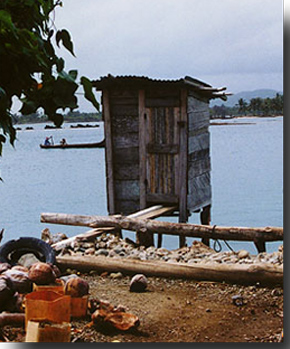
|
|
The Kuna women, are most well known for their molas. Intricately hand sewn pieces of fabric with symmetrical traditional designs or scenes from their traditions, stories of every day life and the nature around them. They are beautifully bright and colorful, with varying degrees of quality. The best one's we saw, you couldn't even find the stitches if you tried. These woman row out to your boat on flat seas or 25 knots of wind in their "ulus" to sell them to you for very reasonable prices by standards at home. The younger girls with less experience and less resources at their disposal were even willing to trade items such as rice, oil or t-shirts for their work.
Buy and trade we did. The joke on our boat is you can take the girl out of the fabric store but you can always find more fabric. I made you proud mom.
The women themselves wear the molas as part of their blouses. A sarong type cloth is tied around their waist, and possibly one around their head with short hair. Their shins and forearms covered entirely in strings upon strings of beads and their noses decorated with a henna type tattoo and a gold nose ring. They are a beauty to behold in their own right. |
|

Kuna women's leg wrapping in strings of beads
|
The Kuna Indians are a matrilineal society with the women in charge of finances and traditions being passed down through her. Not arranged marriages, the woman usually chooses her husband at an age when she is considered mature enough by her family. After marriage, a husband moves into her home with her parents, bringing only the clothes on his back and a machete. He works under his father-in-law as care taker of the vegetable and coconut farms, and fishing. When he has earned enough money to buy fins and masks for skin diving he will then dive for lobsters and such.
Though most of the Sailahs, or tribal chiefs, we met were men, the woman hold the authority over ceremonies relating to the girls maturity into puberty, marriage and religious ceremonies. These ceremonies are often celebrated in the chicha hut, with an intoxicating drink they make out of sugar cane. |
|
| Pourvenir
Having visited a few of the various island groups at this point we decided we better check into the country. Pourvenir is the "officialdom" location to complete that task. We sailed in nasty 25-30 knot winds complaining until we noticed the locals out sailing in their ulus in the same weather. When they could no longer point high enough into the wind they took down their sail and paddled the rest of the way home in steep and choppy seas. Add to this that we have never seen an ulu that didn't already leak. They usually have one person along just for the bailing. We complained no more. Paid our money and enjoyed the rest of our stay.
|
Makatupu
We decided to follow down wind to stay the night in a protected inlet named Bahia de Tiburon. We subsequently found out there are no sharks that live in this inlet but we didn't really try our luck out for too long.
We did find Raphael.
We had been carrying around our old and torn head sail for months now, waiting for just the right new owner. Raphael paddled by offering us fish and fruit of which we needed none, but we inquired if he had any use for the sail. With widened eyes and speaking only spanish he most certainly did. We thought it would get cut up into pieces and become sails for many an ulu. We were wrong.
|
|
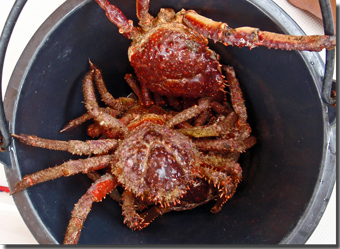 |
He paddled back to our boat a few times and tried to repay us with buckets of large and lovely crabs. Unfortunately we knew that the shell fish season closed only days before, so once he left we returned them to the sea. He supplied us with many a coconut and fish but then invited us to his island and home to meet the Sailah.
The next day we took our dinghy and followed him home. |
|
Raphael lives on the island of Makatupu with his wife and 5 children in her fathers and mothers home, along with her sister, husband and their 7 children. We learned that our sail was to become the new roof to their perpetually leaking hut and they were all overjoyed at the prospect of a drier season ahead.
Raphael's father in law, Antonio Perez, was surprisingly, the only member of the family who could or would speak perfect English with us. He once worked in Panama City and proudly displayed his ID card so we could take a new photo of it. |
|
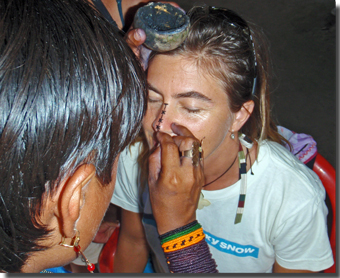
|
They gave us a tour of the island which is about the size of a small, small, town block. Maybe 15 huts in all. We met the chief and visited the congresso. All the while we contemplated a pick game of hoops on the full size basketball court. Then Bruce volunteered Lisa to become a member of the tribe and get her nose tattooed. We thought it was simply charcol but now we think it is more like a henna pigment. It lasts longer than you would think... She drew the line at the gold nose ring but could really go for the arms and legs adorned with beads.
We bid farewell and thankful that we owned an outboard motor, were happy to not have to row all the way back to our boat.
|
|
Chichime
Our final stop was the island chain of Chichime. One last remote haven in the windy Caribbean. We waited for the right weather window to make our dash toward the Panama Canal and of course, bought a few more molas. With some big winds at our back we made our move toward Colon. The photo to the left is of our pals s/v Redwood Coast. A trimaran that often leaves us in the dust. This would be a photo just before that happened.
A one night stop over at Isla Linton, and the next day we found ourselves weaving in between the big container ships. Each of us, big or small, was preparing for a transit of the Panama Canal.
|
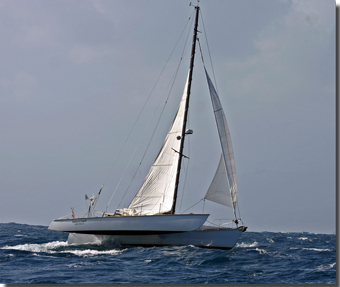
Two out of three hulls riding high for our pals Redwood Coast on our run for the Panama Canal
|
| |